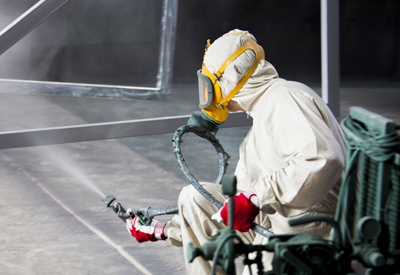Transfer Efficiency
 Transfer efficiency is the measure of how much paint makes it from the container onto the surface being painted. More importantly, the overall transfer efficiency of a specific coating refers to the amount of coating needed to get the proper dry film thickness. The type of coating material and application method used impact transfer efficiency.
Transfer efficiency is the measure of how much paint makes it from the container onto the surface being painted. More importantly, the overall transfer efficiency of a specific coating refers to the amount of coating needed to get the proper dry film thickness. The type of coating material and application method used impact transfer efficiency.
Improved transfer efficiency uses less paint per finished product, which can reduce air emissions from solvents and reduce the rate of paint entering booth filters and landing on the floor and walls of the spray booth. High transfer efficiency rates reduce the amount of paint wasted while minimizing solid and liquid wastes, and air emissions.
Improving spray application coating equipment and operator technique are two ways to improve your transfer efficiency.
Equipment
To achieve the best transfer efficiency possible, you should assess the your application equipment and evaluate its performance using each coating material considered appropriate for your application. Each combination of application equipment and coating creates its own characteristics. Weigh these results against the specifications set for your finished product. For example, if increasing transfer efficiency results in a coating film thickness that is greater than specified, materials will be wasted. Different types of spray application coating equipment are available and have differing impacts on transfer efficiency. Learn more about them here.
Operator Technique
An operator’s technique affects transfer efficiency and if improved upon or corrected will reduce waste. When using spray equipment, maintaining the distance between the gun tip and painting surface according to equipment specifications will help ensure the proper film thickness. For electrostatic applications, the distance between the spray tip and the part also affects the charge the paint maintains.
Gun angle relative to the painting surface also affects transfer efficiency. Keeping the spray gun perpendicular to the painting surface helps avoid uneven coverage that might otherwise require more paint than necessary to produce an acceptable finish.
One tool to assist spray painters is Laser Paint. Mounted on a spray gun, the Laser Paint unit emits two laser beams that converge into one dot when the gun is properly positioned. The visual signal of both lasers coming together on a part lets operators instantly know if they have proper aim, gun-to-part distance and gun angle.
Another tool to improve operator technique is virtual reality spray painting. Virtual reality software and equipment can be customized to match the parts painted at your company along with the coating viscosities, fluid pressures, air pressures and spray equipment you have. Painters can be trained virtually with no mess, waste or reject parts. Virtual reality spray painting was developed by the Johnson Center for Virtual Reality and Pine Technical College. The Iowa Waste Reduction Center at the University of Northern Iowa also offers VirtualPaint software that provides another training opportunity for painters.
Triggering the spray gun on and off at the appropriate time will minimize overspray and improve finish quality. Also important are proper spray overlap and the speed of the stroke.
Training and experience will provide operators with a knowledge of the various painting techniques needed to paint parts of different configurations. Different techniques are helpful when painting inside and outside corners, or slender, round, flat, large and small parts. Training options are available through trade associations, material suppliers, and equipment vendors.
Industry Case Studies
- Ultra Image Powder Coating (2008). An intern helped Ultra Image Powder Coating reduce the amount of waste material generated through the painting process, thereby reducing the raw material used and costs associated with purchase and disposal.
- Wenger Corporation (2000). With the help of a MnTAP intern, Wenger decreased paint use by increasing transfer efficiency from 75 to 93%, saving over 12,000 pounds of powder and over $81,000 annually.
- Medallion Kitchens (1992). An intern identified part placement, spray adjustment, and overspray reuse options to increase transfer efficiency.